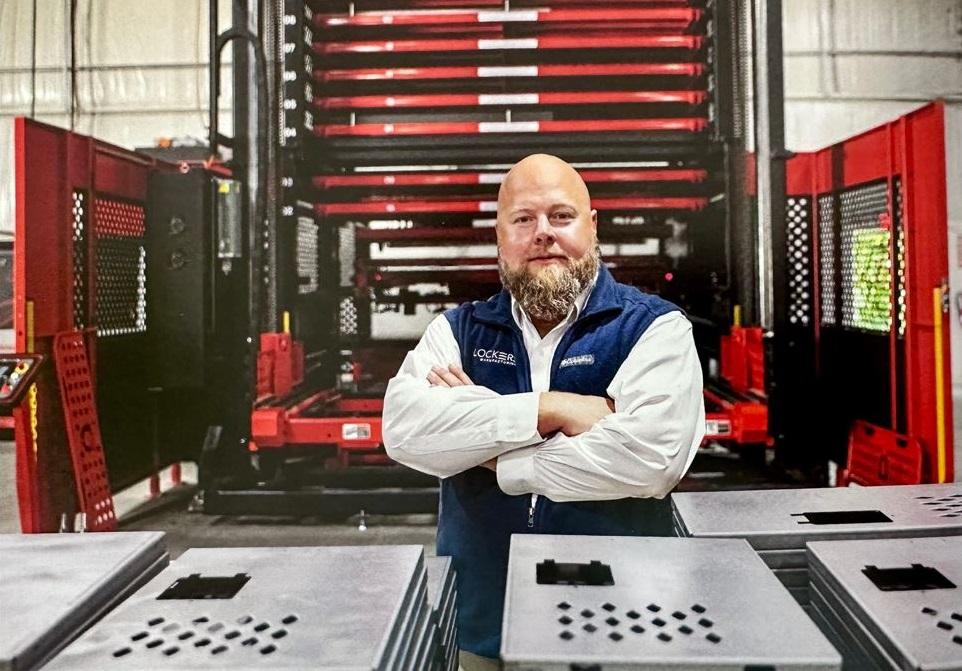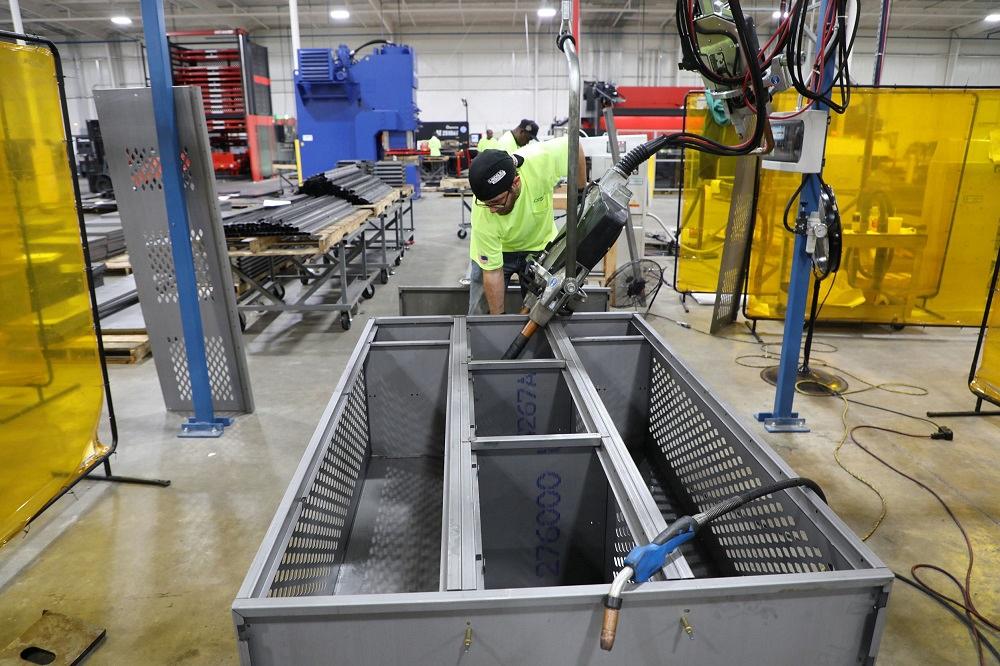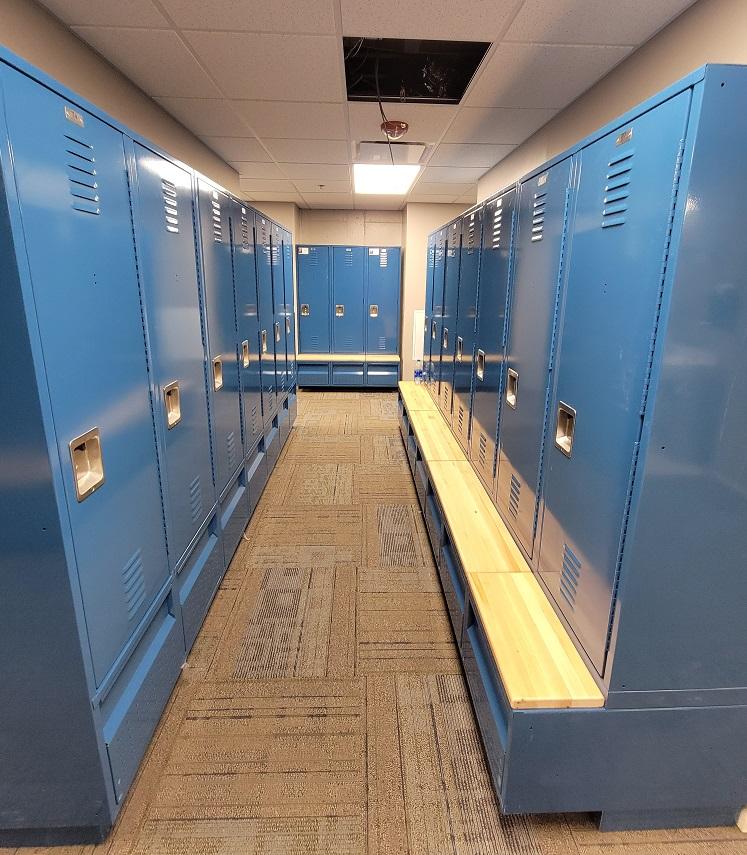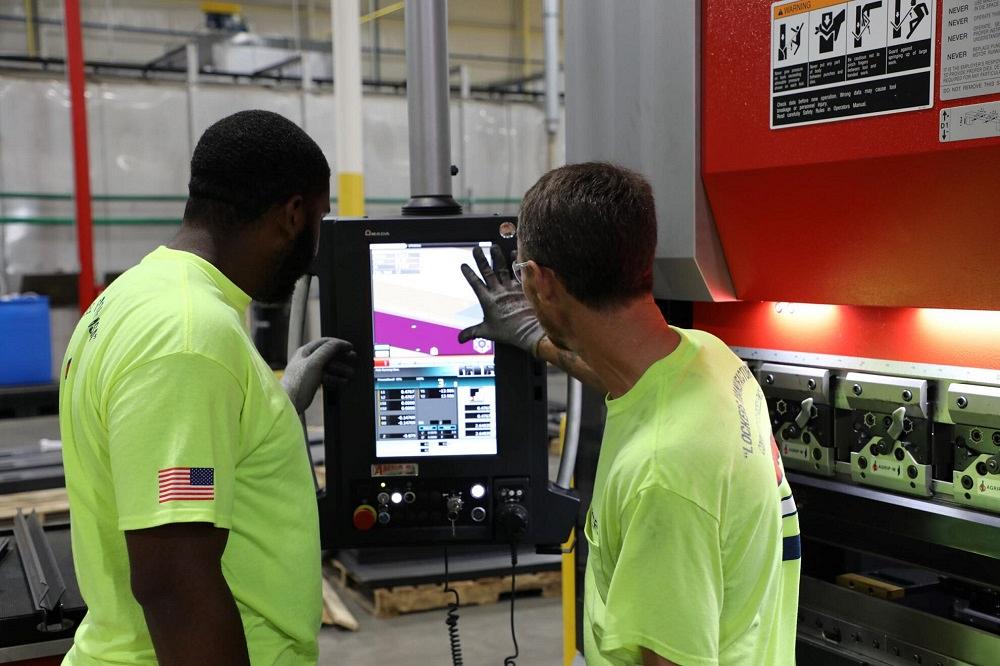Senior Editor
- FMA
- The Fabricator
- FABTECH
- Canadian Metalworking
Categories
- Additive Manufacturing
- Aluminum Welding
- Arc Welding
- Assembly and Joining
- Automation and Robotics
- Bending and Forming
- Consumables
- Cutting and Weld Prep
- Electric Vehicles
- En Español
- Finishing
- Hydroforming
- Laser Cutting
- Laser Welding
- Machining
- Manufacturing Software
- Materials Handling
- Metals/Materials
- Oxyfuel Cutting
- Plasma Cutting
- Power Tools
- Punching and Other Holemaking
- Roll Forming
- Safety
- Sawing
- Shearing
- Shop Management
- Testing and Measuring
- Tube and Pipe Fabrication
- Tube and Pipe Production
- Waterjet Cutting
Industry Directory
Webcasts
Podcasts
FAB 40
Advertise
Subscribe
Account Login
Search
Locker manufacturer embraces reshoring, stateside production opportunities
Mississippi-based Lockers Mfg. designs with the entire value chain in mind
- By Tim Heston
- Updated August 25, 2023
- August 24, 2023
- Article
- Shop Management

Keith Dunham, CEO, launched LockersMFG nine years ago in Batesville, Miss. It’s now a highly automated, 60-employee enterprise.
When people talk of reshoring and a U.S. manufacturing renaissance, they usually speak in vague terms, maybe spouting off a few big-dollar numbers from Wall Street banks or California research firms. As CEO of Lockers Manufacturing (LockersMFG), Keith Dunham talks about reshoring differently. He uses down-to-earth terms, describes the real opportunities reshoring brings, and has a 60-employee, nine-year-old manufacturing business to show for it.
Dunham’s Batesville, Miss., operation produces lockers that, like cars with good fit and finish, sound solid when the doors close. The frame’s C-channel design conceals hardware and strengthens the structure. Tabs behind the locker anchor to the wall to ease installation and secure the locker bank in place. The powder coat seals the surface through a seven-stage (1,000-hour spray test) process. These lockers are designed and produced to last decades.
“If the manufacturing is good, the shipping is good, and the installation is good, the customer is going to have a great experience,” Dunham said. “To create that experience, you’ve got to bring all those elements together.”
In Dunham’s view, the value that LockersMFG provides isn’t just in bent and powder coated sheet metal. It’s about customization, product improvement, voice-of-the-customer feedback, and analyzing the entire value chain—from the material quality to cutting, forming, painting, ease of assembly, ease of shipping and installation, ease of use, user safety, cost of maintenance, and everything else that goes into the product life cycle. Purchasing a locker system is anything but transactional.
The company’s approach exemplifies the advantages of a shorter, agile, and more responsive supply chain, and shows the opportunities unleashed when people stop assuming the U.S. just isn’t in the manufacturing business anymore, especially for something as seemingly simple as a storage locker.
At first glance, a storage locker just looks like a six-sided metal box. When you delve into the details, though, you find that a locker system is not as simple as it looks.
The Domestic Locker Market
Dunham grew up in the locker business. He spent many summers working at his father’s wholesale company, packaging and shipping locker components from various manufacturers, some of them domestic and others from overseas. That mix of domestic and imported products remains in today’s storage locker market, and LockersMFG is one of the newest domestic players.
“It’s a stable, legacy market, and there aren’t many people who know how to serve it,” Dunham said. “There’s a high barrier to entry. We’re probably the first competitor to enter the market in 20 to 30 years.”
The market is far from monolithic; demands vary depending on the customer and the specific sector they serve. Education buys about half its lockers from overseas providers, half from domestic players. The same goes for lockers used by Fortune 500 companies, including fitness centers. More military lockers are made domestically, while more smart lockers are made offshore. “And we’re trying to become one of the premier smart locker players out there,” Dunham said.
If you’ve picked up an order from Amazon at a Whole Foods Market, you’ve used a smart locker, a market that’s expected to grow dramatically in the coming years. Some large apartment towers, instead of employing a full-time concierge, now utilize smart lockers too. They’re used by various companies to streamline the last mile of delivery. When someone places a package (or anything else) in them, sensors detect the item inside and signal the system to automatically notify the needed parties.

An employee positions a resistance spot welding head to join a locker frame member. Stations also incorporate gas metal arc welding. Note the C-frame return flange around the perimeter. These extra bends add strength to the assembly.
Precision Fab Meets the Locker Business
Dunham recalled working in his dad’s wholesale business, attempting to package lockers that comprised sheet metal likely bottomed on an old press brake or stamped with a dedicated die, assembled around an angle-iron frame. “The angle iron would be cut, and everything on the inside would be exposed. And the angle iron itself was just difficult to work with from an installation standpoint.”
From this insight came the seed of LockersMFG, which Dunham launched in 2014 with the aim of enhancing the traditional locker design. He considered not just manufacturability but also installation and, ultimately, the user’s experience. Within some locker designs, hardware and metal edges remain exposed, leaving a multitude of pinch points. Bare hardware can protrude beyond the frame surface. Connections between sheet metal and angle iron cause friction and pinch points too. The corners, which likely get less paint coverage, rust first.
Could lockers be designed more robustly without using excess material? Also, could they be customized to the exact dimension a customer needed? Turns out, with some novel thinking and modern equipment, LockersMFG could make it all happen. Today, the company’s locker sizes range from 12 by 12 by 36 in. up to 48 by 30 by 108 in.
Dunham pointed again to the C-channel design, formed by air bending a return flange on one of the company’s new AMADA press brakes. He then pointed to the corners where, barely visible below the coating, three strategically placed spot welds hid. These, combined with the C-channel, increase the entire structure’s strength—no angle iron required.
“We focus on the corners for welding,” Dunham said, “where we reinforce the structure with overlapping frame members. And the frame members are tabbed so they can be fitted exactly where they need to be.”
The idea during installation and use is to reduce play between assembled components. Locker doors are opened and closed repeatedly, and play between connection points can reduce life significantly. It’s one reason the door hinges are sometimes actually resistance spot welded to the frame, not simply tack welded or screwed on with hardware.
That said, there’s a balance. Dunham pointed to some door hinges that were riveted to the frame, a recent design change that came from a voice-of-the-customer exercise. That rivet secures the assembly but still allows users to remove and replace a single door, should it become damaged. The company does still offer welded doors, though.
“We just tell the client that they’ll lose that opportunity to lower maintenance cost in the future, should something happen. We’re a believer in letting the market choose. Our job is to give the market the best options possible.”
Dunham again pointed to the resistance spot welds strategically placed around a locker’s C-channel frame—all virtually invisible under a 2-mil-thick layer of powder coating that’s double the industry standard.
“The reason we do 2 mil [of coating] is not just to say we do. It’s just a baseline for doing it right, to ensure coverage in the corners and prevent the rust from moving in. A lot of these lockers go into heavy-traffic, wear-and-tear environments. Showers can be nearby, and condensation can build up. These lockers can stand up in those environments.”
Equipment Strategy
Visit LockersMFG’s plant today, and you won’t see any brake operator spending excessive time setting up a machine. All bending programs are written and simulated offline. Sheet followers help a single operator wield a long workpiece and increase accuracy, especially considering the narrow return flanges operators create in those large workpieces.
Feeding the forming department is a blanking area consisting of several automated 3-kW fiber lasers with two 15-shelf towers and a collection of AMADA turret punch presses.
For LockersMFG, that mix of technology works. The laser gives LockersMFG design flexibility and quick-response prototyping, which sets the company apart from the competition. And because the laser produces lights-out, operators arrive in the morning with a healthy buffer of work ready to be processed for the day.
The company uses the turret punch presses for special forms like louvers as well as cluster-punch tools designed to create diamond perforations. The turret’s rigid cluster punches have proven, high-quality results. If they’re well maintained and well sharpened, the tools produce a burr-free edge.
Not every part requires a diamond perforation, and only certain pieces require louvers or other features created by punch form tools. So, having an automated laser cutting process alongside a collection of standalone punches makes sense. In effect, by focusing its automation at the primary laser cutting operation, LockerMFGs utilizes automation where it has the greatest impact.
Getting Granular With Data
Dunham and his team aren’t basing operational strategy on hunches or simple observation, either. They’re basing it on data—not just based on operators clocking in and out of jobs, but from tapping directly into machines on the floor.
“We’re now using AMADA Influent,” Dunham said, explaining that the system connects directly with machines on the floor. It tracks uptime, optimization, and provides a variety of real-time indicators. “We can access it to see how well we were using our machines this week. What was the uptime? What was the downtime?”
He added that the system also flags maintenance issues like lens changes, filter changes, even slat cleaning and changes for the cutting tables. After all, a laser can be tuned perfectly in every way, yet as the slats build with laser cutting slag, variability rears its ugly head.
Perhaps even more significant, the system tracks operations as they relate to specific jobs, including setup/changeover and run times, and puts the flow in context with the other jobs on the floor. Because LockersMFG produces a variety of different locker products and customizes them to the nth degree, the operation in many ways resembles a purely custom fab shop, with umpteen job routings flowing through various departments—cutting, bending, resistance spot welding—coming together in the seven-stage powder coating line, then being separated and staged for final assembly.
Today, Influent helps show how well its machines produce a specific part flow at any given moment. Consider the forming department. It lacks an automatic tool change brake—and for good reason, at least at this writing. Although the operation resembles a custom fab shop, it’s still a locker manufacturer, and it has control over the bend radii it assigns and the forms it creates. Its punches have the necessary reliefs that give clearance for the return flanges (including the channels it creates to strengthen the locker frame), and its die widths account for the variety of material thicknesses it produces. Most are 14- to 20-ga. cold-rolled steel, but the shop also runs a fair amount of 14- to 16-ga. hot-rolled pickled and oiled (HRP&O) material. Every brake cell has staged tooling at the ready. Machines are well maintained, and tool changes aren’t too arduous.
Influent did, however, reveal some inconsistent usage of the company’s brakes. Again, the platform detects granular data, including exactly when the brake ram is moving up and down. In LockersMFG’s case, the software showed the value of longer press brake beds with sheet followers. They could accept a greater variety of parts and they streamlined the forming of some of the company’s longest, most challenging pieces.
The longer press brakes complement two small electric brakes, each of which offer fast rams that quickly form small workpieces. But growing a forming department is a bit like baking a cake: Which additional ingredient would yield the best result? According to Dunham, having software track the granular elements of utilization (ram movement, setup versus run time, reasons for idle time) gives a good recipe for future expansion. Today, that’s likely to include additional 10-ft. brakes, each of which can accept a variety of parts and offer the right balance of optimal throughput and flexibility.
“You’ve Got to Care”
When analysts talk about de-globalization, reshoring, and a stateside manufacturing renaissance, they usually bring up a litany of buzzwords like total landed costs and supply chain resiliency. When you visit LockersMFG, though, you see why stateside manufacturing strikes an emotional chord. No one’s throwing work over the wall and letting someone else deal with problems. Workflow is controlled, organized, and (thanks in part to Influent software) and continually scrutinized.
In the office, engineers don’t work in a silo, aiming to shave pennies off per-part costs. They’re designing with the entire value chain and product life cycle in mind. Every change they make could have far-reaching ripple effects, from tool changes on the plant floor to packaging, delivery, assembly, even locker maintenance years down the road.
How these engineers (and everyone else) interact with others—from shop management to front-line operators, assemblers, and packagers—effectively creates the shop culture. “We have engagement here,” Dunham said. “We treat people the right way. There’s a family feel here ... We preach unity, not division.”
In the early 2010s, Dunham, who hails from Tennessee, worked with the Panola Partnership, which promotes economic development for the Panola County, Mississippi, Chamber of Commerce. “This is a great business climate, and politicians here are rally behind manufacturing. We found the complete package in the Panola County market.”
That included an available labor force. Over the 18 months prior to opening its doors in 2014, the fabricator received more than 1,000 resumes. “We started filtering that down, and we ended up hiring between 5% and 10%,” Dunham said. “Our HR manager is really good at what he does.”
The company employs a mix of experienced people and novices. “We have a blend of people. Some bring the energy, others bring the experience, and we need both. And we have a promote-from-within culture. People know they’ll have opportunity here if they apply themselves. For us, keeping options open for upward mobility is key for retention.”
Some are cross-trained; others are happy to focus on one process. Most important, “there are no dividing lines here,” Dunham said, adding that lines between departments, or between the office and shop floor, fosters inefficiency and ultimately creates a frustrating place to work.
He added that having modern equipment helps, too. Every machine has documented working instructions and a set way of operating, based on the physical principles of cutting, bending, forming, and coating. There are no dinosaur machines that only certain people know how to run.
According to Dunham, every change in manufacturing is considered with worker safety and comfort in mind. The sheet followers are an obvious example, but so is the company’s welding department. Much of the joining is performed with a resistant spot welding process, not gas metal arc welding. “By removing the need for that kind of welding, we eliminate the need for grinding. By eliminating the grinding, we don’t worry about air pollution, particulate in the air, or scuffs or marks on the steel. At the end of the day, our product is going to be seen. It’s almost like a furniture piece.”
Dunham reiterated the importance of growth opportunities presented by the company’s target markets, especially smart lockers, as well as the market’s embrace of customization. After all, if the locker market didn’t value those services, the LockersMFG business model really wouldn’t work. But the demand is there, even in today’s uncertain economy. According to Dunham, the organization plans to double the size of its manufacturing facility over the next 36 months.
Today, potential customers can even work with a locker design portal online (dubbed the “design studio”) to get the process started. That sparks the creative process to optimize not just manufacturability and shipping, but installation, use, durability, and maintenance throughout the life cycle.
Operators on the floor might not have all this in mind. But in general terms, they know how their work fits into a larger value-creation puzzle. And because it’s not just about the part in front of them, but how their role serves people up and down the value chain, it’s work worth caring about. Dunham summed it up this way: “We don’t have a hugely complicated statement about our culture. If you work here, you’ve got to care. If you don’t care, you can’t work here.”
About the Author

Tim Heston
2135 Point Blvd
Elgin, IL 60123
815-381-1314
Tim Heston, The Fabricator's senior editor, has covered the metal fabrication industry since 1998, starting his career at the American Welding Society's Welding Journal. Since then he has covered the full range of metal fabrication processes, from stamping, bending, and cutting to grinding and polishing. He joined The Fabricator's staff in October 2007.
Related Companies
subscribe now

The Fabricator is North America's leading magazine for the metal forming and fabricating industry. The magazine delivers the news, technical articles, and case histories that enable fabricators to do their jobs more efficiently. The Fabricator has served the industry since 1970.
start your free subscription- Stay connected from anywhere

Easily access valuable industry resources now with full access to the digital edition of The Fabricator.

Easily access valuable industry resources now with full access to the digital edition of The Welder.

Easily access valuable industry resources now with full access to the digital edition of The Tube and Pipe Journal.
- Podcasting
- Podcast:
- The Fabricator Podcast
- Published:
- 04/16/2024
- Running Time:
- 63:29
In this episode of The Fabricator Podcast, Caleb Chamberlain, co-founder and CEO of OSH Cut, discusses his company’s...
- Trending Articles
Tips for creating sheet metal tubes with perforations

JM Steel triples capacity for solar energy projects at Pennsylvania facility

Are two heads better than one in fiber laser cutting?

Supporting the metal fabricating industry through FMA

Omco Solar opens second Alabama manufacturing facility

- Industry Events
16th Annual Safety Conference
- April 30 - May 1, 2024
- Elgin,
Pipe and Tube Conference
- May 21 - 22, 2024
- Omaha, NE
World-Class Roll Forming Workshop
- June 5 - 6, 2024
- Louisville, KY
Advanced Laser Application Workshop
- June 25 - 27, 2024
- Novi, MI





























